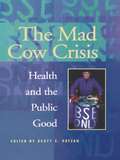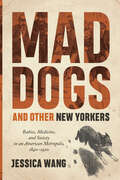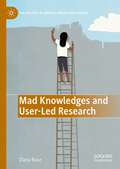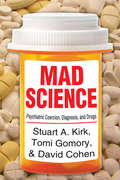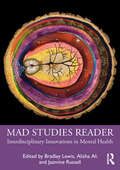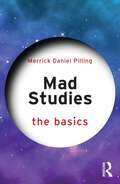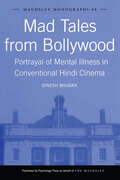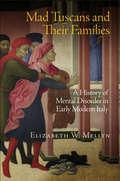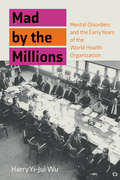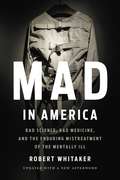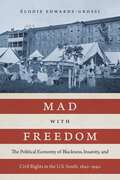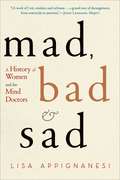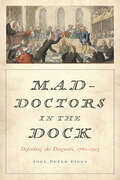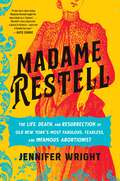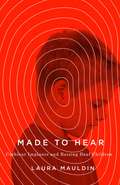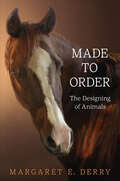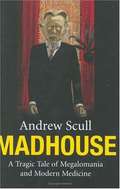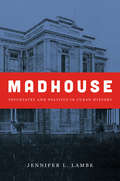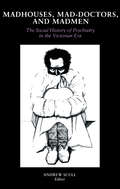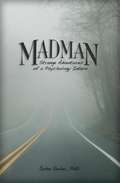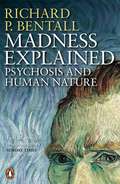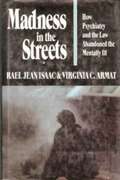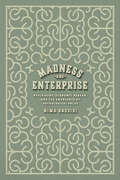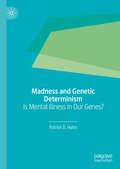- Table View
- List View
Mad Cow Crisis: Health And The Public Good
by Scott C. RatzanThe announcement that BOSER might cause a fatal human disease "Creutzfeldt- Jacob disease CJD" triggered enormous media attention, public alarm and government wrangling that threatened the future of European integration.; As Scott Ratzan argues: "It is my belief that the [BOSER crisis] represents a quintessential case that will go down in history as the Exxon Valdez Union Carbide's Bhopal accident, and other such cases of interdisciplinary study".; This book offers lessons learned from the crisis, with contributions from experts with different viewpoints - veterinarians, Eurocrats, public relations experts, politicians, policy- makers, journalists and representatives of the beef industry.; It also offers a compilation of the key reports from governmental bodies. as a case-study in policy-making, scientific/health discovery and dissemination of information, as well as looking at the issues from the perspective of psychology and media studies.
Mad Dogs and Other New Yorkers: Rabies, Medicine, and Society in an American Metropolis, 1840–1920 (Animals, History, Culture)
by Jessica WangHow rabid dogs, the struggles to contain them, and their power over the public imagination intersected with New York City's rise to urban preeminence.Rabies enjoys a fearsome and lurid reputation. Throughout the decades of spiraling growth that defined New York City from the 1840s to the 1910s, the bone-chilling cry of "Mad dog!" possessed the power to upend the ordinary routines and rhythms of urban life. In Mad Dogs and Other New Yorkers, Jessica Wang examines the history of this rare but dreaded affliction during a time of rapid urbanization. Focusing on a transformative era in medicine, politics, and urban society, Wang uses rabies to survey urban social geography, the place of domesticated animals in the nineteenth-century city, and the world of American medicine. Rabies, she demonstrates, provides an ideal vehicle for exploring physicians' ideas about therapeutics, disease pathology, and the body as well as the global flows of knowledge and therapeutics. Beyond the medical realm, the disease also illuminates the cultural fears and political contestations that evolved in lockstep with New York City's burgeoning cityscape.Mad Dogs and Other New Yorkers offers lay readers and specialists alike the opportunity to contemplate a tumultuous domain of people, animals, and disease against a backdrop of urban growth, medical advancement, and social upheaval. The result is a probing history of medicine that details the social world of New York physicians, their ideas about a rare and perplexing disorder, and the struggles of an ever-changing, ever-challenging urban society.
Mad Knowledges and User-Led Research (The Politics of Mental Health and Illness)
by Diana Susan RoseThis book presents a critical examination of the development of user involvement within research, and investigates the issues currently preventing a productive integration of Mad knowledges within research and practice. Drawing on social, linguistic and critical theories, it proposes the conditions needed to address the development of Mad epistemologies. The author’s unique approach deliberately highlights her own positionality and draws on decades of experience as a service recipient, survivor, activist and researcher to illustrate the structural and symbolic barriers faced. Employing concepts including epistemic injustice, individualization, normalization and structural violence, it suggests a radically new way of articulating ‘what’s the matter with us?’ In doing so, the book itself goes some way towards enacting the radical challenge to academic and epistemic hierarchies which, it is argued, will be required to further advance mad knowledges and user-led research. Crucially, it demonstrates how this approach can be both methodologically and conceptually rigorous. This novel work holds important insights for students and scholars across the humanities and social sciences; particularly those working in the areas of critical psychology, disability studies, Mad studies, feminist studies, critical race theory, and Queer theory.
Mad Science: Psychiatric Coercion, Diagnosis, and Drugs
by Stuart A. Kirk*Winner of an honorable mention from theSociety for Social Work and ResearchforOutstanding Social Work Book AwardMad Science argues that the fundamental claims of modern American psychiatry are based on misconceived, flawed, and distorted science. The authors address multiple paradoxes in American mental health research, including the remaking of coercion into scientific psychiatric treatment, the adoption of an unscientific diagnostic system that controls the distribution of services, and how drug treatments have failed to improve the mental health outcome.When it comes to understanding and treating mental illness, distortions of research are not rare, misinterpretation of data is not isolated, and bogus claims of success are not voiced by isolated researchers seeking aggrandizement. This book's detailed analysis of coercion and community treatment, diagnosis, and psychopharmacology reveals that these characteristics are endemic, institutional, and protected in psychiatry. They are not just bad science, but mad science.This book provides an engaging and readable scientific and social critique of current mental health practices. The authors are scholars, researchers, and clinicians who have written extensively about community care, diagnosis, and psychoactive drugs. This paperback edition makes Mad Science accessible to all specialists in the field as well as to the informed public.
Mad Studies Reader: Interdisciplinary Innovations in Mental Health
by Bradley Lewis, Alisha Ali and Jazmine RussellThe last few years have brought increased writings from activists, artists, scholars, and concerned clinicians that cast a critical and constructive eye on psychiatry, mental health care, and the cultural relations of mental difference. With particular focus on accounts of lived experience and readings that cover issues of epistemic and social injustice in mental health discourse, the Mad Studies Reader brings together voices that advance anti-sanist approaches to scholarship, practice, art, and activism in this realm.Beyond offering a theoretical and historical overview of mad studies, this Reader draws on the perspectives, voices, and experiences of artists, mad pride activists, humanities and social science scholars, and critical clinicians to explore the complexity of mental life and mental difference. Voices from these groups confront and challenge standard approaches to mental difference. They advance new structures of meaning and practice that are inclusive of those who have been systematically subjugated and promote anti-sanist approaches to counter inequalities, prejudices, and discrimination. Confronting modes of psychological oppression and the power of a few to interpret and define difference for so many, the Mad Studies Reader asks the critical question of how these approaches may be reconsidered, resisted, and reclaimed.This collection will be of interest to mental health clinicians; students and scholars of the arts, humanities and social sciences; and anyone who has been affected by mental difference, directly or indirectly, who is curious to explore new perspectives.
Mad Studies: The Basics (The Basics)
by Merrick Daniel PillingMad Studies: The Basics provides an introductory account of a field that emerged from, and must remain grounded within, community knowledge, activism, and the perspectives of those who have experienced madness and mental health systems.It is a concise text that introduces the field through an exploration of some origins of Mad Studies, as well as two interrelated queries: what does Mad Studies help us understand, and what does Mad Studies help us do? This exploration reveals that Mad Studies is an interdisciplinary, intersectional, and multi-vocal field that demands different answers to the very meaning of the beliefs, behaviours, and bodymind experiences that are currently characterized as being indicative of mental illness. At the heart of Mad Studies is a liberationist desire to resist, transform, and abolish the systems that create marginalization, and implement responses to madness that are grounded in the collective knowledge of those deemed Mad. This book shows that the contributions of Indigenous, Black, racialized, queer, and trans people must be understood as central to, and already embedded within, Mad Studies and activism rather than as add-ons, expansions, or efforts to make Mad Studies more inclusive.It will be of interest to all scholars and students of disability studies, social work, gender studies, education, health sciences, sociology, and psychology, as well as practitioners in mental health care, and those with lived experience of madness and mental health systems.
Mad Tales from Bollywood: Portrayal of Mental Illness in Conventional Hindi Cinema (Maudsley Series #48)
by Dinesh BhugraThis is the first book to investigate how mental illness is portrayed in Hindi cinema. It examines attitudes towards mental illness in Indian culture, how they are reflected in Hindi films, and how culture has influenced the portrayal of the psychoses. Dinesh Bhugra guides the reader through the history of Indian cinema, covering developments from the idealism of the 1950s to the stalking, jealousy and psychopathy that characterises the films of the 1990s. Critiques of individual films demonstrate the culture’s approach towards mental illness and reflect the impact of culture on films and vice versa. Subjects covered include: Cinema and emotion Attitudes towards mental illness Socio-economic factors and cinema in India Indian personality, villainy and history Psychoanalysis in the films of the 60s. Mad Tales from Bollywood will be of interest to psychiatrists, mental health professionals, students of media and cultural studies and anyone with an interest in Indian culture.
Mad Tuscans and Their Families
by Elizabeth W. MellynBased on three hundred civil and criminal cases over four centuries, Elizabeth W. Mellyn reconstructs the myriad ways families, communities, and civic and medical authorities met in the dynamic arena of Tuscan law courts to forge pragmatic solutions to the problems that madness brought to their households and streets. In some of these cases, solutions were protective and palliative; in others, they were predatory or abusive. The goals of families were sometimes at odds with those of the courts, but for the most part families and judges worked together to order households and communities in ways that served public and private interests.For most of the period Mellyn examines, Tuscan communities had no institutions devoted solely to the treatment and protection of the mentally disturbed; responsibility for their long-term care fell to the family. By the end of the seventeenth century, Tuscans, like other Europeans, had come to explain madness in medical terms and the mentally disordered were beginning to move from households to hospitals. In Mad Tuscans and Their Families, Mellyn argues against the commonly held belief that these changes chart the rise of mechanisms of social control by emerging absolutist states. Rather, the story of mental illness is one of false starts, expedients, compromise, and consensus created by a wide range of historical actors.
Mad by the Millions: Mental Disorders and the Early Years of the World Health Organization (Culture and Psychiatry)
by Harry Yi-Jui WuThe World Health Organization's post-World War II work on the epidemiology and classification of mental disorders and its vision of a "world psyche."In 1946, the World Health Organization undertook a project in social psychiatry that aimed to discover the epidemiology and classification of mental disorders. In Mad by the Millions, Harry Y-Jui Wu examines the WHO's ambitious project, arguing that it was shaped by the postwar faith in technology and expertise and the universalizing vision of a "world psyche." Wu shows that the WHO's idealized scientific internationalism laid the foundations of today's highly highly metricalized global mental health system.
Mad in America: Bad Science, Bad Medicine, and the Enduring Mistreatment of the Mentally Ill
by Robert WhitakerAn updated edition of the classic history of schizophrenia in America, which gives voice to generations of patients who suffered through "cures" that only deepened their suffering and impaired their hope of recoverySchizophrenics in the United States currently fare worse than patients in the world's poorest countries. In Mad in America, medical journalist Robert Whitaker argues that modern treatments for the severely mentally ill are just old medicine in new bottles, and that we as a society are deeply deluded about their efficacy. The widespread use of lobotomies in the 1920s and 1930s gave way in the 1950s to electroshock and a wave of new drugs. In what is perhaps Whitaker's most damning revelation, Mad in America examines how drug companies in the 1980s and 1990s skewed their studies to prove that new antipsychotic drugs were more effective than the old, while keeping patients in the dark about dangerous side effects. A haunting, deeply compassionate book-updated with a new introduction and prologue bringing in the latest medical treatments and trends-Mad in America raises important questions about our obligations to the mad, the meaning of "insanity," and what we value most about the human mind.
Mad with Freedom: The Political Economy of Blackness, Insanity, and Civil Rights in the U.S. South, 1840–1940
by Élodie Edwards-GrossiThe use of race in studies of insanity in the 1840s and 1850s gave rise to politically charged theories on the differential biology and pathologies of brains in whites and Blacks. In Mad with Freedom, Élodie Edwards-Grossi explores the largely unknown social history of these racialized theories on insanity in the segregated South. She unites an institutional history of psychiatric spaces in the South that housed Black patients with an intellectual history of early psychiatric theories that defined the Black body as a locus for specific pathologies. Edwards-Grossi also reveals the subtle, localized techniques of resistance later employed by Black patients to confront medical power. Her work shows the continuous politicization of science and theories on insanity in the context of Reconstruction and the Jim Crow South.
Mad, Bad and Sad: A History of Women and the Mind Doctors
by Lisa AppignanesiThis fascinating history of mind doctors and their patients probes the ways in which madness, badness, and sadness have been understood over the last two centuries. Lisa Appignanesi charts a story from the days when the mad were considered possessed to our own century when the official psychiatric manual lists some 350 mental disorders. Women play a key role here, both as patients "among them Virginia Woolf, Sylvia Plath, and Marilyn Monroe" and as therapists. Controversially, Appignanesi argues that women have significantly changed the nature of mind-doctoring, but in the process they have also inadvertently highlighted new patterns of illness.
Mad-Doctors in the Dock: Defending the Diagnosis, 1760–1913
by Joel Peter EigenA captivating history of the defense of the insanity plea in England.Shortly before she pushed her infant daughter headfirst into a bucket of water and fastened the lid, Annie Cherry warmed the pail because, as she later explained to a police officer, "It would have been cruel to put her in cold water." Afterwards, this mother sat down and poured herself a cup of tea. At Cherry’s trial at the Old Bailey in 1877, Henry Charlton Bastian, physician to the National Hospital for the Paralyzed and Epileptic, focused his testimony on her preternatural calm following the drowning. Like many other late Victorian medical men, Bastian believed that the mother’s act and her subsequent behavior indicated homicidal mania, a novel species of madness that challenged the law’s criterion for assigning criminal culpability.How did Dr. Bastian and his cohort of London’s physicians, surgeons, and apothecaries—originally known as "mad-doctors"—arrive at such an innovative diagnosis, and how did they defend it in court? Mad-Doctors in the Dock is a sophisticated exploration of the history of the insanity defense in the English courtroom from the middle of the eighteenth century to the early twentieth century. Joel Peter Eigen examines courtroom testimony offered in nearly 1,000 insanity trials, transporting us into the world of psychiatric diagnosis and criminal justice. The first comprehensive account of how medical insight and folk psychology met in the courtroom, this book makes clear the tragedy of the crimes, the spectacle of the trials, and the consequences of the diagnosis for the emerging field of forensic psychiatry.
Madame Restell: The Life, Death, and Resurrection of Old New York's Most Fabulous, Fearless, and Infamous Abortionist
by Jennifer Wright**Longlisted for the Brooklyn Public Library Book Prize in Nonfiction (2023)** **An Amazon EDITOR'S PICK for BEST BOOKS OF 2023 SO FAR in BIOGRAPHY/MEMOIR and HISTORY** **An Amazon EDITOR'S PICK for BEST BOOKS OF THE MONTH (March 2023)** **A Bookshop.Org EDITOR'S PICK (March 2023)** &“This is the story of one of the boldest women in American history: self-made millionaire, a celebrity in her era, a woman beloved by her patients and despised by the men who wanted to control them.&” An industrious immigrant who built her business from the ground up, Madame Restell was a self-taught surgeon on the cutting edge of healthcare in pre-Gilded Age New York, and her bustling &“boarding house&” provided birth control, abortions, and medical assistance to thousands of women—rich and poor alike. As her practice expanded, her notoriety swelled, and Restell established her-self as a prime target for tabloids, threats, and lawsuits galore. But far from fading into the background, she defiantly flaunted her wealth, parading across the city in designer clothes, expensive jewelry, and bejeweled carriages, rubbing her success in the faces of the many politicians, publishers, fellow physicians, and religious figures determined to bring her down. Unfortunately for Madame Restell, her rise to the top of her field coincided with &“the greatest scam you&’ve never heard about&”—the campaign to curtail women&’s power by restricting their access to both healthcare and careers of their own. Powerful, secular men—threatened by women&’s burgeoning independence—were eager to declare abortion sinful, a position endorsed by newly-minted male MDs who longed to edge out their feminine competition and turn medicine into a standardized, male-only practice. By unraveling the misogynistic and misleading lies that put women&’s lives in jeopardy, Wright simultaneously restores Restell to her rightful place in history and obliterates the faulty reasoning underlying the very foundation of what has since been dubbed the &“pro-life&” movement. Thought-provoking, character-driven, boldly written, and feminist as hell, Madame Restell is required reading for anyone and everyone who believes that when it comes to women&’s rights, women&’s bodies, and women&’s history, women should have the last word.
Made to Hear: Cochlear Implants and Raising Deaf Children (A Quadrant Book)
by Laura MauldinA mother whose child has had a cochlear implant tells Laura Mauldin why enrollment in the sign language program at her daughter&’s school is plummeting: &“The majority of parents want their kids to talk.&” Some parents, however, feel very differently, because &“curing&” deafness with cochlear implants is uncertain, difficult, and freighted with judgment about what is normal, acceptable, and right. Made to Hear sensitively and thoroughly considers the structure and culture of the systems we have built to make deaf children hear.Based on accounts of and interviews with families who adopt the cochlear implant for their deaf children, this book describes the experiences of mothers as they navigate the health care system, their interactions with the professionals who work with them, and the influence of neuroscience on the process. Though Mauldin explains the politics surrounding the issue, her focus is not on the controversy of whether to have a cochlear implant but on the long-term, multiyear undertaking of implantation. Her study provides a nuanced view of a social context in which science, technology, and medicine are trusted to vanquish disability—and in which mothers are expected to use these tools. Made to Hear reveals that implantation has the central goal of controlling the development of the deaf child&’s brain by boosting synapses for spoken language and inhibiting those for sign language, placing the politics of neuroscience front and center.Examining the consequences of cochlear implant technology for professionals and parents of deaf children, Made to Hear shows how certain neuroscientific claims about neuroplasticity, deafness, and language are deployed to encourage compliance with medical technology.
Made to Order: The Designing of Animals
by Margaret E. DerryAnimal breeding has been complicated by persisting factors across species, cultures, geography, and time. In Made to Order, Margaret E. Derry explains these factors and other breeding concerns in relation to both animals and society in North America and Europe over the past three centuries. Made to Order addresses how breeding methodology evolved, what characterized the aims of breeding, and the way structures were put in place to regulate the occupation. Illustrated by case studies on important farm animals and companion species, the book presents a synthetic overview of livestock breeding as a whole. It gives considerable emphasis to genetics and animal breeding in the post-1960 period, the relationship between environmental and improvement breeding, and regulation of breeding as seen through pedigrees. In doing so, Made to Order shows how studying the ancient human practice of animal breeding can illuminate the ways in which human thinking, theorizing, and evolving characterize our interactions with all-natural processes.
Mader's Understanding Human Anatomy and Physiology
by Susannah N. LongenbakerMader’s Understanding Human Anatomy and Physiology continues to be the perfect text for a one-semester course, because it was designed for this audience from the very first edition. The text is celebrating its tenth anniversary with a complete facelift, which I believe makes the content even more approachable, user friendly and exciting. Each chapter now begins with an infographic that details fascinating facts about the chapter’s subject.
Madhouse: A Tragic Tale of Megalomania and Modern Medicine
by Andrew ScullMadhouse reveals a long-suppressed medical scandal, shocking in its brutality and sobering in its implications. It shows how a leading American psychiatrist of the early twentieth century came to believe that mental illnesses were the product of chronic infections that poisoned the brain. Convinced that he had uncovered the single source of psychosis, Henry Cotton, superintendent of the Trenton State Hospital, New Jersey, launched a ruthless campaign to "eliminate the perils of pus infection." Teeth were pulled, tonsils excised, and stomachs, spleens, colons, and uteruses were all sacrificed in the assault on "focal sepsis." Many patients did not survive Cotton's surgeries; thousands more were left mangled and maimed. Cotton's work was controversial, yet none of his colleagues questioned his experimental practices. Subsequent historians and psychiatrists too have ignored the events that cast doubt on their favorite narratives of scientific and humanitarian progress. In a remarkable feat of historical detective work, Andrew Scull exposes the full, frightening story of madness among the mad-doctors. Drawing on a wealth of documents and interviews, he reconstructs in vivid detail a nightmarish, cautionary chapter in modern psychiatry when professionals failed to police themselves.
Madhouse: Psychiatry and Politics in Cuban History (Envisioning Cuba)
by Jennifer L. LambeOn the outskirts of Havana lies Mazorra, an asylum known to--and at times feared by--ordinary Cubans for over a century. Since its founding in 1857, the island's first psychiatric hospital has been an object of persistent political attention. Drawing on hospital documents and government records, as well as the popular press, photographs, and oral histories, Jennifer L. Lambe charts the connections between the inner workings of this notorious institution and the highest echelons of Cuban politics. Across the sweep of modern Cuban history, she finds, Mazorra has served as both laboratory and microcosm of the Cuban state: the asylum is an icon of its ignominious colonial and neocolonial past and a crucible of its republican and revolutionary futures.From its birth, Cuban psychiatry was politically inflected, drawing partisan contention while sparking debates over race, religion, gender, and sexuality. Psychiatric notions were even invested with revolutionary significance after 1959, as the new government undertook ambitious schemes for social reeducation. But Mazorra was not the exclusive province of government officials and professionalizing psychiatrists. U.S. occupiers, Soviet visitors, and, above all, ordinary Cubans infused the institution, both literal and metaphorical, with their own fears, dreams, and alternative meanings. Together, their voices comprise the madhouse that, as Lambe argues, haunts the revolutionary trajectory of Cuban history.
Madhouses, Mad-Doctors, and Madmen
by Andrew ScullThe Victorian Age saw the transformation of the madhouse into the asylum into the mental hospital; of the mad-doctor into the alienist into the psychiatrist; and of the madman (and madwoman) into the mental patient. In Andrew Scull's edited collection Madhouses, Mad-Doctors, and Madmen, contributors' essays offer a historical analysis of the issues that continue to plague the psychiatric profession today. Topics covered include the debate over the effectiveness of institutional or community treatment, the boundary between insanity and criminal responsibility, the implementation of commitment laws, and the differences in defining and treating mental illness based on the gender of the patient.
Madman: Strange Adventures Of A Psychology Intern
by John R. SulerInternship. Doesn't "intern" mean "to imprison?" We're expected to work our butts off, all in the name of Training. It seemed more like a grueling rite of passage than anything else-- the establishment's last chance to test the limits of the student's psyche before welcoming him to the club.
Madness Explained: Psychosis and Human Nature
by Richard P BentallA revised edition of Madness Explained, Richard Bentall's groundbreaking classic on mental illness In Madness Explained, leading clinical psychologist Richard Bentall shatters the modern myths that surround psychosis. Is madness purely a medical condition that can be treated with drugs? Is there a clear dividing line between who is sane and who is insane? For this revised edition, he adds new material drawing on the recent advances in molecular genetics, new studies of the role of environment in psychosis, and important discoveries on early symptoms preceding illness, among other important developments in our understanding.'Madness Explained is a substantial, yet highly accessible work. Full of insight and humanity, it deserves a wide readership.' Sunday Times 'Will give readers a glimpse both of answers to their own problems, and to questions about how the mind works' Independent Magazine Richard P. Bentall holds a Chair in Experimental Clinical Psychology at the University of Manchester. In 1989 he received the British Psychological Society's May Davidson Award for his contribution to the field of Clinical Psychology.
Madness In The Streets: How Psychiatry And The Law Abandoned The Mentally Ill
by Rael J. Isaac Virginia C. ArmatExamines the cultural and political issues surrounding the problem of America's homeless mentally ill
Madness and Enterprise: Psychiatry, Economic Reason, and the Emergence of Pathological Value
by Nima BassiriUncovers a powerful relationship between pathology and money: beginning in the nineteenth century, the severity of mental illness was measured against a patient’s economic productivity. Madness and Enterprise reveals the economic norms embedded within psychiatric thinking about mental illness in the North Atlantic world. Over the course of the nineteenth century, various forms of madness were subjected to a style of psychiatric reasoning that was preoccupied with money. Psychiatrists across Western Europe and the United States attributed financial and even moral value to an array of pathological conditions, such that some mental disorders were seen as financial assets and others as economic liabilities. By turning to economic conduct and asking whether potential patients appeared capable of managing their financial affairs or even generating wealth, psychiatrists could often bypass diagnostic uncertainties about a person’s mental state. Through an exploration of the intertwined histories of psychiatry and economic thought, Nima Bassiri shows how this relationship transformed the very idea of value in the modern North Atlantic, as the most common forms of social valuation—moral value, medical value, and economic value—were rendered equivalent and interchangeable. If what was good and what was healthy were increasingly conflated with what was remunerative (and vice versa), then a conceptual space opened through which madness itself could be converted into an economic form and subsequently redeemed—and even revered.
Madness and Genetic Determinism: Is Mental Illness in Our Genes?
by Patrick D. HahnThe book covers important topics in the psychiatric genetics (PG) field. Many of these have been overlooked in mainstream accounts, and many contemporary PG researchers have omitted or whitewashed the eugenic and “racial hygiene” origins of the field. The author critically analyzes PG evidence in support of genetic claims which, given the lack of gene discoveries, are based mainly on the results of psychiatric twin and adoption studies. Given that the evidence in favor of genetic influences is much weaker than mainstream sources report, due to serious issues in twin and adoption research, the author points to environmental factors, including trauma, as the main causes of conditions such as schizophrenia.
